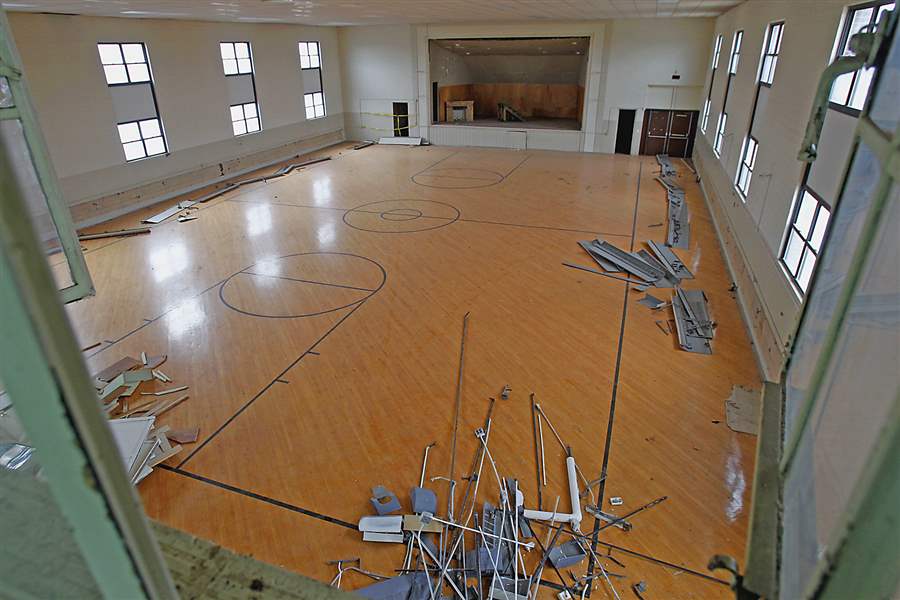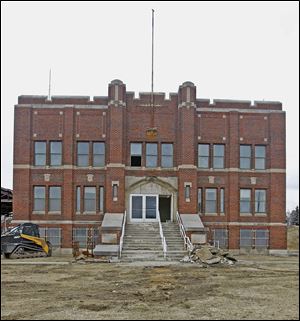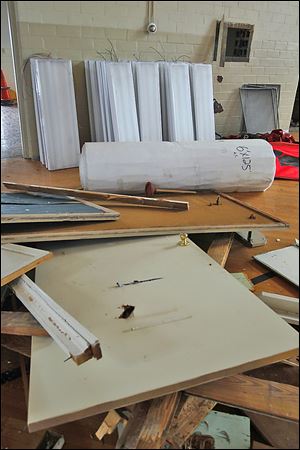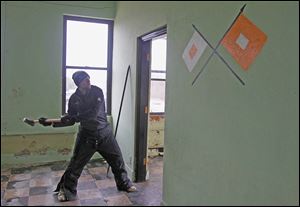
Crews dismantle Armory for demolition
Monroe community salutes memories of local landmark
3/25/2013
The armory's gymnasium floor is one item that could not be salvaged and will end up in a landfill. It has too many nails and was breaking apart.
The Blade/Lori King
Buy This Image

A crew from Greenscape of Lake, Mich., has been removing and salvaging items from the 85-year-old Armory’s main building ahead of its demolition this week.
MONROE — Area residents were saying their good-byes last week to a longtime presence in the community: the 85-year-old former Michigan Army National Guard armory.
A crew from Greenscape landscaping and excavating, of Lake, Mich., has been preparing the main building to be demolished this week. A side building has been undergoing a slow knockdown for a little more than a week.
“We have been trying to minimize the dust and debris that would cover the neighborhood if we took it down too quickly,” Brian Cataldo, company owner, said.
Part of preparing the main structure for demolition is removing all metal and other salvageable objects from inside the building to be sold at scrap auction. One item that didn’t have to go to auction was the flagpole, which was bought by a local resident who stopped by after he saw the construction crews.
“I didn’t get his name, but he said it would mean a lot to him, that the place had a lot of memories,” Mr. Cataldo said.
Other items that were salvaged from the building were several dozen fluorescent light fixtures, which were painstakingly removed by the crew.
The gymnasium floor is one item that could not be salvaged and will end up in a landfill.

Crews have salvaged several dozen fluorescent light fixtures from the building.
“We tried, but there were just too many nails in it, and it was breaking all apart when we tried to lift it up,” Mr. Cataldo said.
HomeTown Pharmacy plans to construct a 7,000-square-foot retail pharmacy with drive-thru services, said Jim Grice, vice president of the Newaygo-based company that operates 28 stores in Michigan.
Construction bids are being assembled with the expectation of ground breaking in mid-May, he said.
“A realistic goal will be to complete the building by the end of September,” Mr. Grice said. “The new location will include a drive-thru window, expanded lines of new merchandise, immunizations, diagnostic testing, and a full-service medical-equipment business.”
Despite its longtime presence in the community, the utilitarian building with few architectural flourishes either inside or out does not merit a mention on the Monroe County Historical Museum’s Web site.
Christine Kull, museum curator/certified archivist, was able to find only one undated newspaper article that detailed the 1929 opening of the new building, which was designed by the city’s architect, Reed M. Dunbar, and approved by the state military board. It was constructed by S. Berkebile and Son of Delta, Ohio.
“The exterior reminds me of a number of school buildings built through the years,” said Michael Hauser, historian at La-Z-Boy, a Monroe company that has been around since 1927, even longer than the armory. “Architecturally, it looks more functional than elaborate.”
The later years have not been kind to the building, he said, noting the bars across the lower windows and the addition of metal doors.

The armory's gymnasium floor is one item that could not be salvaged and will end up in a landfill. It has too many nails and was breaking apart.
“I am sure there would have been nice wood doors at one time and possibly elaborate exterior light fixtures,” Mr. Hauser said.
The 1929 article about the construction of the building said it was to have an auditorium that could seat 900 people or if used as a dining room, 500 people. Not only designed to be a military headquarters, the building was envisioned as a civic center, as well.
Its position on the far south end of town on South Dixie Highway was because of a land donation on March 25, 1926, by Benjamin J. Greening, who had constructed a subdivision of houses behind the armory.
The state Legislature appropriated $60,000 for the construction of the two-story building. The two National Guard companies which were to occupy the building contributed an additional $10,000, to be paid from funds received from the rental of the whole or parts of the building.
Longtime Monroe resident Ann Lux, 67, remembers going to dances at the Armory when she was in high school.
“Also, an auctioneer, Bill Nichols, used to hold estate auctions there,” she recalls. “I had a great time at those.”
Another memory of Mrs. Lux is that of the National Guard trucks and Jeeps being loaded up at the facility to head to Grayling in the summer.

Greenspace worker Nick Gillespie removes door frames in preparation to demolish the Michigan National Guard armory in Monroe.
Stephen Murphy, 63, of Monroe, also attended dances but has more vivid memories of attending a wrestling match at the armory in the early 1960s, one that featured Leaping Larry Chene vs. Brute Bernard.
Earlier in its history, the National Guard mustered out of the Armory during the famous 1937 Newton Steel Co. strike.
A Blade story from that time recounts how 425 National Guardsmen set up a military camp at the armory. Monroe citizens who had been asked by the mayor to remain indoors satisfied their curiosity by visiting the armory grounds and viewing the troops. Michigan Gov. Frank Murphy also visited the armory to inspect the troops and confer with military officials.
Monroe is not the only local city to see a historic armory be turned into a site for a drugstore.
The Bowling Green City Council approved the rezoning of south side of the 200 block of East Wooster Street, which would allow the building of a CVS store on the ground now occupied by the former Ohio National Guard armory. It has been vacant since the National Guard moved to the city’s new community center in 2006.